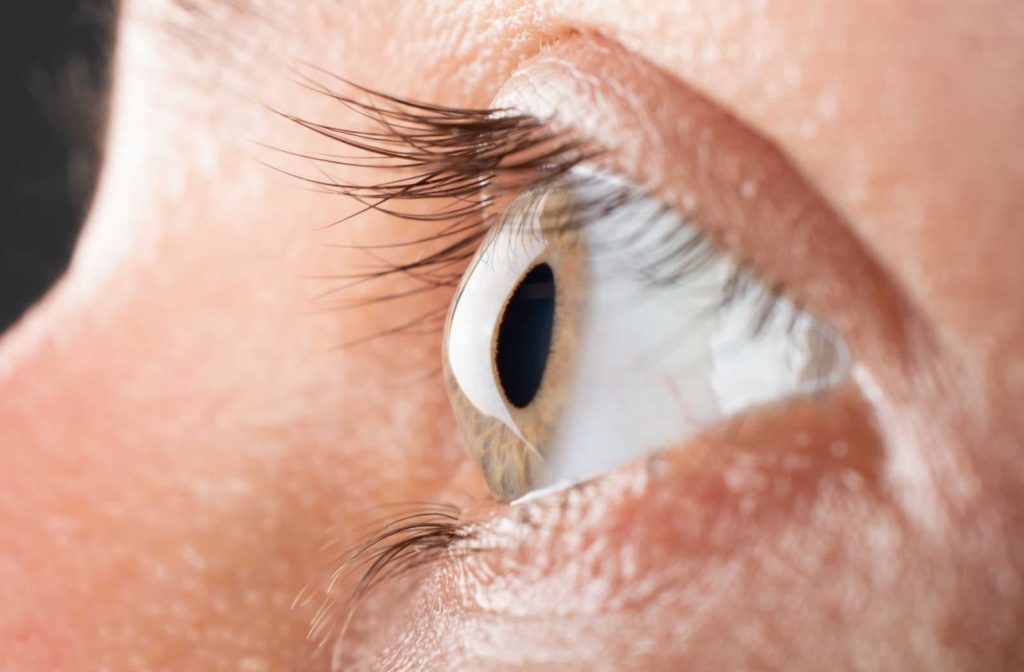Keratoconus is a condition caused by your cornea protruding into a cone-like shape, while astigmatism is caused by an imperfection in the cornea or lens of your eyes. Both conditions can result in blurry vision. If you’ve recently been struggling with blurry vision, it’s important to get your eyes checked to be sure that you don’t have any new eye conditions.
While keratoconus and astigmatism have similar symptoms, they do have a key difference. If you have blurred vision, scheduling a comprehensive eye exam with your optometrist will help you determine the exact cause and your treatment options for conditions like keratoconus and astigmatism.
What Is Keratoconus?
Keratoconus is a condition where your cornea, the clear surface of your eye, thins over time and eventually reaches a cone-like shape. Symptoms typically develop between the ages of 10-25 and continue developing until around the age of 40.
The middle of your cornea is primarily small protein fibers called collagen. When healthy, collagen gives your eye its natural round shape. This allows it to focus rays of light into the retina itself and help your eye properly build an image of what it’s looking at.
When this layer of collagen begins to thin, the cornea starts to become shaped like a cone, slowly becoming steeper as time passes. The eye then becomes irregularly shaped and can’t efficiently focus light into the retina.
What are the symptoms of keratoconus?
Keratoconus can cause irregular astigmatism and has several additional symptoms that can negatively affect your day-to-day life.
- Blurry vision
- Headaches
- Sensitivity to light
- Double vision
- Nearsightedness
How Is Keratoconus Treated?
Speciality Contact Lenses
Keratoconus can be alleviated with several kinds of contact lenses. Some of the lenses that can help include:
- Rigid gas-permeable (RGP) lenses: RGP lenses are made of a firm material that may seem uncomfortable at first but becomes more natural-feeling over time.
- Soft contact lenses: These lenses are made of a softer material and are ideal for earlier stages of keratoconus. However, as keratoconus progresses, you may need to change and update your prescription with your optometrist.
- Hybrid lenses: A mix of the two lenses above, these are designed with a hard center and soft exterior, which can make them preferable to standard rigid gas-permeable lenses
- Scleral lenses. These can be useful for people with advanced keratoconus. Rather than sitting on your cornea, they arch over it to sit on the whites of your eyes. This creates a smooth surface to help refract light into your retina.
It’s best to speak with your optometrist before purchasing any contact lenses. By getting a precise prescription, you can ensure you’re making the right decision for your eyes.
Surgical Procedures
Alternatively, a procedure called corneal collagen cross-linking can be performed to help treat keratoconus with specific eyedrop medication and UV treatment that can increase the strength of your corneal tissue. This can’t prevent any previous damage done to your eyes by keratoconus but rather focuses on stopping the condition from worsening.
In more extreme cases, there are two additional surgeries available:
- Full corneal transplant from a donor, where the entire cornea is replaced.
- Deep anterior lamellar keratoplasty (DALK), which preserves the internal tissue of your cornea to avoid any potential problems or complications with a corneal transplant.

Astigmatism
The eye’s natural shape allows the cornea and the lens to effectively bend light towards the retina and clearly see images in the world around it. Astigmatism occurs when your eye’s shape changes or distorts.
This makes it so that the lens and cornea can’t bend light properly toward the retina. Light rays will normally reach a singular point on the retina to create an image of what you’re seeing. Due to astigmatism, the rays will instead hit different points, which creates a blurry or double image.
Astigmatism can vary from person to person. It also typically is associated with other refractive vision issues, such as myopia or keratoconus. Genetics also play a large part in your risk of developing astigmatism, and the condition is often present from birth.
There are two types of astigmatism: regular and irregular.
Regular astigmatism is caused by an improper curvature of the cornea or natural lens of your eye. Despite it being evenly misshapen, it still has a natural steady curvature of the surface. Irregular astigmatism is when the curve of the lens or cornea isn’t uniform but rather changes from point to point.
Astigmatism can be managed and treated with specialty contact lenses or corrective laser surgery like LASIK.
Symptoms of Astigmatism
The symptoms of astigmatism can include:
- Blurry vision
- Headaches
- Constant squinting
- Poor night vision
- Eye strain
What to Do if You Have Blurry Vision
The symptoms of astigmatism and keratoconus are similar, but they are caused by two separate conditions. Put simply:
- Keratoconus is caused by your cornea misshaping into a cone-like shape.
- Astigmatism is caused by a curve in your cornea or lens.
Dealing with blurry vision or other symptoms caused by these two conditions can be frustrating. However, speaking with your optometrist can help you find a treatment that can correct your vision.
To speak with a knowledgeable eye care professional about whether specialty lenses or other treatments are right for you, book an appointment with Perspective Eye Center today.



